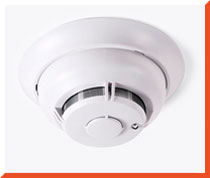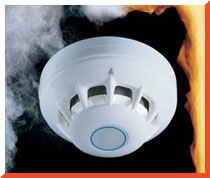Fire Detection and Alarm Systems
These systems act like watchdogs, enabling the detection of a fire at a really early stage so that it can be extinguished easily with minimal property damage. These systems are instrumental in saving lives and avoiding damage to property, provided the fire-fighting response has been planned and provided for.
A variety of application-specific detectors including Ionization Smoke Detectors, Photo Electric Smoke detectors, Duct Detectors, Beam detectors, Thermal detectors are used. The microprocessor based control panel has diagnostic features to detect failure of any elements within the system and has a battery backup for uninterrupted operation.
When a fire breaks out, the sensors detect smoke and/or increase in heat beyond preset values, triggering off the alarm. If an occupant detects the fire, the Manual Call Points can be operated to manually generate an alarm. Along with an indication of the zone in which the fire is detected, the dual tone Electronic hooters and/or flashing strobe lights are activated, enabling early evacuation andfire-fighting response. The alarm can also be communicated to a remote (for instance, the fire station) location through an automatic dialer. Response Indicators or Remote indicators are used in conjunction, with detectors that are installed at a location normally hidden from view, like above false ceiling, below raised floors, etc.,.
This indicator would then indicate the status of the particular detector that it is connected to. This enables speedy isolation of fires,even, when the affected area is hidden from view.
Photoelectric Smoke Detectors:
Photoelectric smoke detectors use a light source and sensor to achieve detection of smoke. The light and sensor are positioned at 90-degree angles to one another.
In the normal case, the light from the light source on the left shoots straight across and misses the sensor. When smoke enters the chamber, however, the smoke particles scatter the light and some amount of light hits the sensor: The sensor then sets off the siren, by sending an alarm signal to the control Panel. Photoelectric detectors are better at sensing smoky fires.

Ionization Smoke Detectors:
Ionization smoke detectors use an ionization chamber and a source of ionizing radiation to detect smoke. This type of smoke detector is more common because it is inexpensive and better at detecting the smaller amounts of smoke produced by flaming fires. The electronics in the smoke detector sense the small amount of electrical current that the electrons and ions moving toward the plates represent. This flow of current is caused by the presence of the ionizing material (Americium) present near one of the plates.
When smoke enters the ionization chamber, it disrupts this current -- the smoke particles attach to the ions and neutralize them. The smoke detector senses the drop in current between the plates and sets off the hooters, by sending an alarm signal to the control Panel
Thermal Detectors:
a) Fixed Temperature based detectors, give out an alarm signal, when surrounding temperature climbs beyond a preset value. For normal applications, depending on the nature of the site, detectors with preset values of 60°C to 70°C are available.
b) Rate of Rise detectors are incorporated with thermal sensors that track the rate of increase of temperature. When the increase in temperature is quite sudden and not gradual, the detector sends out an alarm.
c) A combination of the above two principles are incorporated into one unit, to provide reliable Heat Detectors.

Fire alarm systems are normally 24V DC based systems
I) Addressable Fire Alarm System is the answer for large institutional buildings, where the source of fire needs to be located quickly. Addressable Smoke detectors give the exact location of the fire/smoke, and one can immediate localize the precise area under threat, by reading the information off the Central Fire Alarm Control Panel display. The sensitivity and other specific features of each detector can be programmed through an Intelligent Addressable Control Panel that communicates with its devices through sophisticated data protocols
II) Conventional Fire Alarm System would be the answer, where smaller cost effective fire detection systems are required. Conventional detectors, upon detecting smoke, set off the particular zone that they are connected to. The central control panel, indicates the general area of fire, and effective fire fighting action can be taken.





















